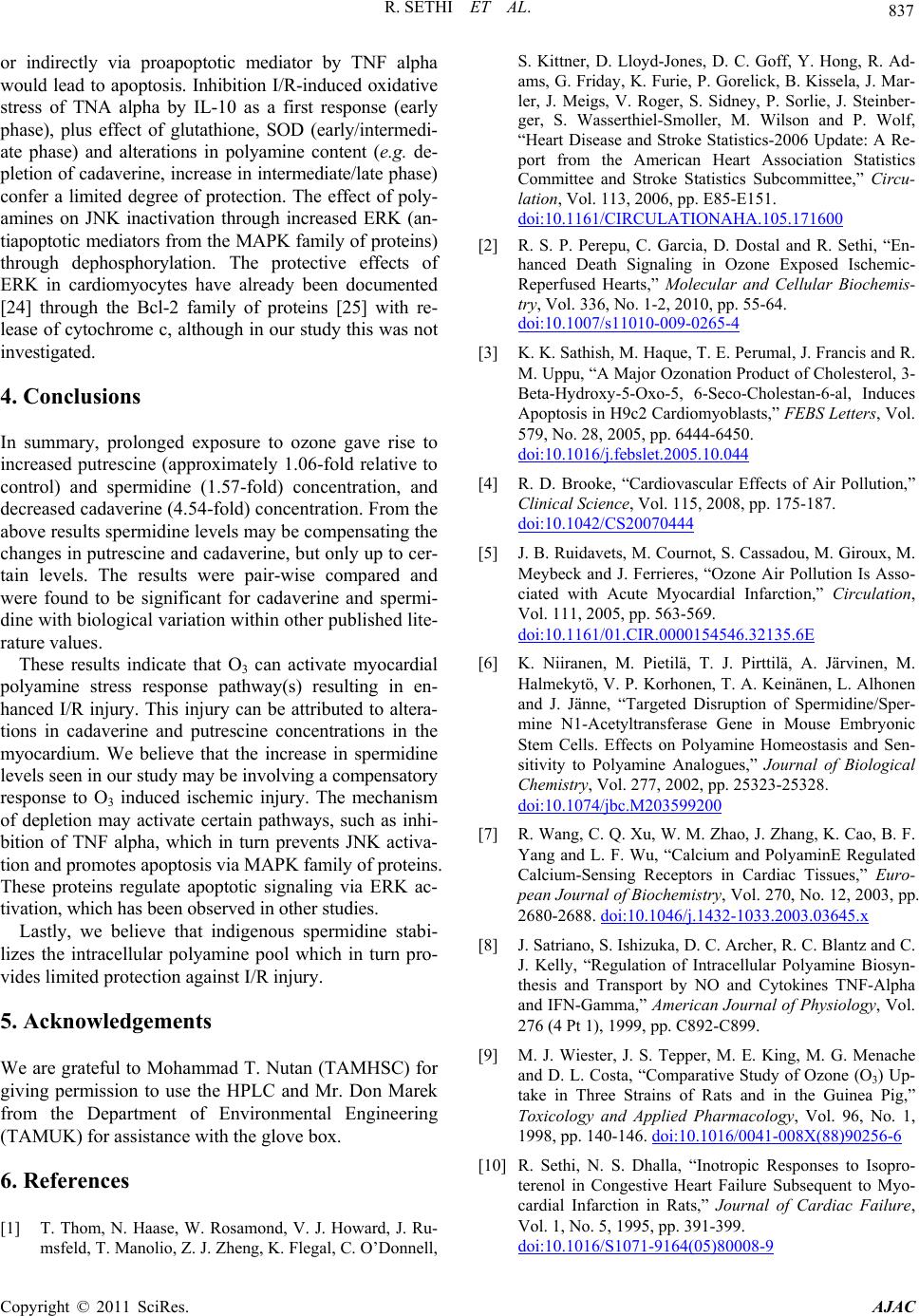
837
R. SETHI ET AL.
or indirectly via proapoptotic mediator by TNF alpha
would lead to apoptosis. Inhibition I/R-induced oxidative
stress of TNA alpha by IL-10 as a first response (early
phase), plus effect of glutathione, SOD (early/intermedi-
ate phase) and alterations in polyamine content (e.g. de-
pletion of cadaverine, increase in intermediate/late phase)
confer a limited degree of protection. The effect of poly-
amines on JNK inactivation through increased ERK (an-
tiapoptotic mediators from the MAPK family of proteins)
through dephosphorylation. The protective effects of
ERK in cardiomyocytes have already been documented
[24] through the Bcl-2 family of proteins [25] with re-
lease of cytochrome c, although in our study this was not
investigated.
4. Conclusions
In summary, prolonged exposure to ozone gave rise to
increased putrescine (approximately 1.06-fold relative to
control) and spermidine (1.57-fold) concentration, and
decreased cadaverine (4.54-fold) concentration. From the
above results spermidine levels may be compensating the
changes in putrescine and cadaverine, but only up to cer-
tain levels. The results were pair-wise compared and
were found to be significant for cadaverine and spermi-
dine with biological variation within other published lite-
rature values.
These results indicate that O3 can activate myocardial
polyamine stress response pathway(s) resulting in en-
hanced I/R injury. This injury can be attributed to altera-
tions in cadaverine and putrescine concentrations in the
myocardium. We believe that the increase in spermidine
levels seen in our study may be involving a compensatory
response to O3 induced ischemic injury. The mechanism
of depletion may activate certain pathways, such as inhi-
bition of TNF alpha, which in turn prevents JNK activa-
tion and promotes apoptosis via MAPK family of proteins.
These proteins regulate apoptotic signaling via ERK ac-
tivation, which has been observed in other studies.
Lastly, we believe that indigenous spermidine stabi-
lizes the intracellular polyamine pool which in turn pro-
vides limited protection against I/R injury.
5. Acknowledgements
We are grateful to Mohammad T. Nutan (TAMHSC) for
giving permission to use the HPLC and Mr. Don Marek
from the Department of Environmental Engineering
(TAMUK) for assistance with the glove box.
6. References
[1] T. Thom, N. Haase, W. Rosamond, V. J. Howard, J. Ru-
msfeld, T. Manolio, Z. J. Zheng, K. Flegal, C. O’Donnell,
S. Kittner, D. Lloyd-Jones, D. C. Goff, Y. Hong, R. Ad-
ams, G. Friday, K. Furie, P. Gorelick, B. Kissela, J. Mar-
ler, J. Meigs, V. Roger, S. Sidney, P. Sorlie, J. Steinber-
ger, S. Wasserthiel-Smoller, M. Wilson and P. Wolf,
“Heart Disease and Stroke Statistics-2006 Update: A Re-
port from the American Heart Association Statistics
Committee and Stroke Statistics Subcommittee,” Circu-
lation, Vol. 113, 2006, pp. E85-E151.
doi:10.1161/CIRCULATIONAHA.105.171600
[2] R. S. P. Perepu, C. Garcia, D. Dostal and R. Sethi, “En-
hanced Death Signaling in Ozone Exposed Ischemic-
Reperfused Hearts,” Molecular and Cellular Biochemis-
try, Vol. 336, No. 1-2, 2010, pp. 55-64.
doi:10.1007/s11010-009-0265-4
[3] K. K. Sathish, M. Haque, T. E. Perumal, J. Francis and R.
M. Uppu, “A Major Ozonation Product of Cholesterol, 3-
Beta-Hydroxy-5-Oxo-5, 6-Seco-Cholestan-6-al, Induces
Apoptosis in H9c2 Cardiomyoblasts,” FEBS Letters, Vol.
579, No. 28, 2005, pp. 6444-6450.
doi:10.1016/j.febslet.2005.10.044
[4] R. D. Brooke, “Cardiovascular Effects of Air Pollution,”
Clinical Science, Vol. 115, 2008, pp. 175-187.
doi:10.1042/CS20070444
[5] J. B. Ruidavets, M. Cournot, S. Cassadou, M. Giroux, M.
Meybeck and J. Ferrieres, “Ozone Air Pollution Is Asso-
ciated with Acute Myocardial Infarction,” Circulation,
Vol. 111, 2005, pp. 563-569.
doi:10.1161/01.CIR.0000154546.32135.6E
[6] K. Niiranen, M. Pietilä, T. J. Pirttilä, A. Järvinen, M.
Halmekytö, V. P. Korhonen, T. A. Keinänen, L. Alhonen
and J. Jänne, “Targeted Disruption of Spermidine/Sper-
mine N1-Acetyltransferase Gene in Mouse Embryonic
Stem Cells. Effects on Polyamine Homeostasis and Sen-
sitivity to Polyamine Analogues,” Journal of Biological
Chemistry, Vol. 277, 2002, pp. 25323-25328.
doi:10.1074/jbc.M203599200
[7] R. Wang, C. Q. Xu, W. M. Zhao, J. Zhang, K. Cao, B. F.
Yang and L. F. Wu, “Calcium and PolyaminE Regulated
Calcium-Sensing Receptors in Cardiac Tissues,” Euro-
pean Journal of Biochemistry, Vol. 270, No. 12, 2003, pp.
2680-2688. doi:10.1046/j.1432-1033.2003.03645.x
[8] J. Satriano, S. Ishizuka, D. C. Archer, R. C. Blantz and C.
J. Kelly, “Regulation of Intracellular Polyamine Biosyn-
thesis and Transport by NO and Cytokines TNF-Alpha
and IFN-Gamma,” American Journal of Physiology, Vol.
276 (4 Pt 1), 1999, pp. C892-C899.
[9] M. J. Wiester, J. S. Tepper, M. E. King, M. G. Menache
and D. L. Costa, “Comparative Study of Ozone (O3) Up-
take in Three Strains of Rats and in the Guinea Pig,”
Toxicology and Applied Pharmacology, Vol. 96, No. 1,
1998, pp. 140-146. doi:10.1016/0041-008X(88)90256-6
[10] R. Sethi, N. S. Dhalla, “Inotropic Responses to Isopro-
terenol in Congestive Heart Failure Subsequent to Myo-
cardial Infarction in Rats,” Journal of Cardiac Failure,
Vol. 1, No. 5, 1995, pp. 391-399.
doi:10.1016/S1071-9164(05)80008-9
Copyright © 2011 SciRes. AJAC